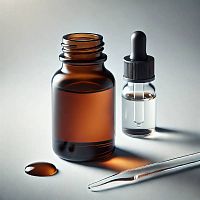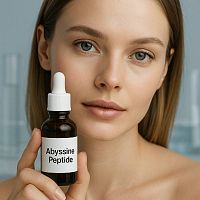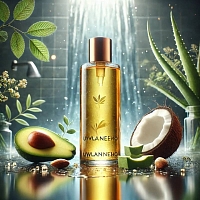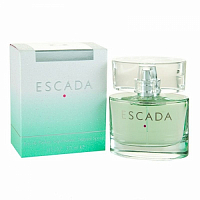-
 Absolutes
Absolutes
-
 Active Complexes
Active Complexes
-
 Actives and Peptides for Cosmetics
Actives and Peptides for Cosmetics
-
 Amino Acids
Amino Acids
-
 Food Flavorings
Food Flavorings
-
 Ayurveda
Ayurveda
-
 Vitamins
Vitamins
-
 Gelling Agents and Thickeners
Gelling Agents and Thickeners
-
 Hydrosols and Floral Waters
Hydrosols and Floral Waters
-
 Hydrolyzed Proteins
Hydrolyzed Proteins
-
 Fragrant and aromatic substances
Fragrant and aromatic substances
-
 Acids, Salts, Alcohols, and Alkalis
Acids, Salts, Alcohols, and Alkalis
-
 Preservatives and Antioxidants
Preservatives and Antioxidants
-
 Cosmetic Raw Materials
Cosmetic Raw Materials
-
 Dyes, Pearlescents, and Glitters
Dyes, Pearlescents, and Glitters
-
 Face Masks, Scrubs, and Dried Flowers
Face Masks, Scrubs, and Dried Flowers
-
 Oils, batters, macerates, oil mixtures
Oils, batters, macerates, oil mixtures
-
 Candle Supplies
Candle Supplies
-
 Melt and Pour Soap Bases
Melt and Pour Soap Bases
-
 Base for cosmetics, cream, serum, shampoo
Base for cosmetics, cream, serum, shampoo
-
 Fragrance Oils
Fragrance Oils
-
 Surfactants
Surfactants
-
 Peelings for Skin
Peelings for Skin
-
 Herbal Powders and Plant
Herbal Powders and Plant
-
 Silicones and Conditioning Surfactants for Hair
Silicones and Conditioning Surfactants for Hair
-
 Raw materials for dietary supplements
Raw materials for dietary supplements
-
 Packaging for Cosmetics and Perfumes
Packaging for Cosmetics and Perfumes
-
 Molds, Packaging, Tools
Molds, Packaging, Tools
-
 Organic Extracts
Organic Extracts
-
 Emollients for Cosmetics
Emollients for Cosmetics
-
 Emulsifiers
Emulsifiers
-
 Essential Oils
Essential Oils
Phenol 10% (Carbolic Acid): Advanced Skincare for Rejuvenation and Purification
Unlock the potent benefits of Phenol 10%, a sophisticated cosmetic ingredient sourced from the USA. Also known as Carbolic Acid or Phenol Peel, this clear liquid solution is expertly formulated with a complex of active ingredients including water, glycerin, steareth-20, N-hydroxysuccinimide, chrysin, palmitoyl oligopeptide, palmitoyl tetrapeptide-7, chlorhexidine digluconate (20% in water at 1%), and potassium sorbate (0.1%). It presents a characteristic odor and is highly soluble in water, alcohol, alkalis, benzene, and acetone, making it a versatile addition to advanced skincare formulations. Designed primarily for peeling, rejuvenation, and cleansing, Phenol 10% offers a powerful solution for addressing various skin concerns.
Description and Key Features
Phenol 10% is a carefully balanced blend that leverages the well-known properties of phenol at a precisely controlled concentration. The inclusion of ingredients like glycerin ensures hydration, while steareth-20 aids in emulsion stability. The sophisticated peptide complex of palmitoyl oligopeptide and palmitoyl tetrapeptide-7, along with N-hydroxysuccinimide and chrysin, points to its application in addressing concerns like dark circles and promoting skin firmness, often associated with anti-aging treatments. The presence of chlorhexidine digluconate provides antiseptic properties, crucial for maintaining skin hygiene, especially during and after peeling procedures. Potassium sorbate acts as a preservative, ensuring product stability and safety. Its liquid form and specific odor are characteristic features, indicative of its composition and intended use.
Advanced Applications and Usage Areas in Cosmetics
Phenol 10% is a professional-grade ingredient primarily intended for advanced cosmetic applications due to its potent activity. Its use should be approached with careful consideration of concentration and skin type.
- Chemical Peeling:
- Light to Medium Depth Peels: At a 10% concentration, Phenol can be incorporated into formulations designed for superficial to medium-depth chemical peels. These peels aim to exfoliate the outermost layers of the skin, promoting cell turnover and revealing fresher, more radiant skin.
- Addressing Photoaging: Effective in reducing the appearance of fine lines, wrinkles, and sun damage (photoaging) by encouraging the shedding of damaged skin cells and stimulating collagen production.
- Hyperpigmentation Correction: Can help in lightening various forms of hyperpigmentation, including age spots, sun spots, and melasma, by accelerating the removal of pigmented epidermal cells.
- Acne Scar Improvement: Aids in smoothing the texture of skin affected by superficial acne scars, leading to a more even complexion.
- Skin Rejuvenation:
- Texture Refinement: By promoting skin regeneration, it contributes to an overall smoother and more refined skin texture.
- Collagen Stimulation: The controlled exfoliation and skin renewal process can indirectly stimulate collagen synthesis, leading to improved skin elasticity and firmness.
- Pore Minimization: Regular exfoliation helps to keep pores clear and can contribute to a more minimized appearance of enlarged pores.
- Intensive Cleansing and Purification:
- Deep Cleansing Treatments: Its properties can be leveraged in formulations designed for deep cleansing, particularly for oily or acne-prone skin, to help remove impurities and excess sebum.
- Antiseptic Support: The inclusion of chlorhexidine digluconate makes it suitable for use in products requiring additional antiseptic benefits, such as pre-procedure skin preparation or post-procedure care to prevent infections.
Important Note: Due to the active nature of Phenol 10%, formulations containing this ingredient are typically for professional use or by individuals with advanced knowledge of cosmetic chemistry and skin physiology. Always perform patch tests and follow strict usage guidelines. Our online store provides worldwide shipping for this specialized cosmetic component.
Cosmetic Recipe: Advanced Rejuvenating Face Peel
This recipe is for a professional-use facial peel designed to promote skin renewal and rejuvenation. This formulation should only be handled and applied by trained professionals or individuals with extensive experience in chemical peels, understanding all safety precautions and aftercare.
| Ingredient | Percentage (%) | Function |
|---|---|---|
| Phase A (Base) | ||
| Distilled Water | 70-75% | Solvent, base for the peel |
| Propylene Glycol | 5% | Humectant, penetration enhancer |
| Hydroxyethylcellulose (or other thickener) | 0.5-1% | Thickening agent, provides suitable viscosity |
| Phase B (Active Peel) | ||
| Phenol 10% Solution | 15% | Active exfoliating and rejuvenating agent |
| Phase C (Soothing & Preserving) | ||
| Allantoin | 0.5% | Soothing, promotes skin healing |
| Green Tea Extract (liquid) | 1% | Antioxidant, anti-inflammatory |
| Preservative (e.g., Liquid Germall Plus) | 0.5% | Protects against microbial growth |
| pH Adjuster (e.g., Lactic Acid or Sodium Hydroxide 20% solution) | As needed | Adjusts final pH to target range (e.g., 2.5-3.5) |
Instructions for Preparation:
- Sanitization: Ensure all equipment (beakers, stirring rods, containers) is thoroughly sanitized using appropriate sterilization methods. Wear gloves, eye protection, and a mask.
- Phase A: In a clean beaker, disperse Hydroxyethylcellulose into the propylene glycol, stirring until fully hydrated and lump-free. Then, slowly add distilled water while continuously stirring until a homogeneous gel forms. Gentle heating may be applied if needed to aid dispersion.
- Phase B: Carefully measure out the Phenol 10% solution and slowly add it to Phase A while stirring continuously. Ensure complete incorporation.
- Phase C: In a separate small container, dissolve Allantoin in a minimal amount of distilled water from Phase A. Add this solution to the main mixture. Then, add the Green Tea Extract and the preservative. Mix thoroughly until all ingredients are well combined.
- pH Adjustment: Use a reliable pH meter to measure the pH of the solution. Carefully adjust the pH to the desired range (e.g., 2.5-3.5) using drops of Lactic Acid (to lower pH) or Sodium Hydroxide solution (to raise pH). Stir well after each addition and re-measure. Achieving the correct pH is critical for efficacy and safety.
- Final Check: Once the pH is stable and the mixture is homogeneous, transfer the peel solution into an appropriate, tightly sealed, opaque container.
Recommendations for Application and Safety:
- Professional Use Only: This formulation is for professional use in a controlled environment or by experienced individuals with a thorough understanding of chemical peel procedures and safety protocols.
- Patch Testing: Always perform a patch test on a small, inconspicuous area of skin at least 24-48 hours before full application to check for adverse reactions.
- Skin Preparation: Cleanse and degrease the skin thoroughly before applying the peel.
- Application: Apply the peel evenly to the target area using a fan brush or cotton swab, avoiding eyes, nostrils, and lips. Observe the skin for frosting or redness.
- Contact Time: The contact time will vary significantly based on skin type, condition, and desired depth of peel. Start with a very short contact time (e.g., 1-2 minutes) and monitor the skin closely. Never leave on for extended periods.
- Neutralization: Always have a neutralizing solution (e.g., 5% sodium bicarbonate solution) readily available to stop the peel immediately if excessive redness, burning, or discomfort occurs. Apply generously to neutralize, then rinse thoroughly with cool water.
- Post-Peel Care: Following the peel, provide thorough post-peel instructions to the user, emphasizing hydration, sun protection (strict avoidance of sun exposure and consistent use of high-SPF sunscreen), and avoidance of abrasive products.
- Storage: Store the finished peel in a cool, dark place, away from direct sunlight, in a tightly sealed container.
- Disclaimer: This recipe is provided for informational purposes only. The user assumes all responsibility for the safe and correct use of ingredients and adherence to all applicable regulations. This information is not intended to replace professional medical advice.
And also go to the Blog from Мыло Опт, where we share useful information about creating the right natural cosmetics
| INCI | Carbolic acid | |
| Other | ||
| Application | peeling, rejuvenation, cleansing | |
| Color product | appropriate | |
| Composition | water, glycerin, steareth-20, N-hydroxysuccinimide, chrysin, palmitoyl oligopeptide, palmitoyl tetrapeptide-7, chlorhexidine digluconate (20% in water): 1%, potassium sorbate: 0.1%. | |
| Descriptio smell | characteristic | |
| Features | All information presented on the site is for reference only | |
| Minimum count | 1 | |
| Name | Phenol 10%, 10 ml | |
| Packaging | container for transportation | |
| Packing | 10 ml | |
| Solubility | water, alcohol, alkali, benzene, acetones | |
| View | liquid | |
-
Date:todayAuthor:Галина, ПрилукиReviews
Шукала натуральні основи для мила. Знайшла їх саме в цьому магазині. Якість чудова, піна пишна. Результатом дуже задоволена!
Date:5 DecemberAuthor:Алиса, НиколаевReviewsДуже вдячна за ваш професійний підхід і якісні товари. Замовляю інгредієнти для косметики у вас постійно, завжди задоволена. Доставка швидка, ціни приємні, обслуговування на висоті. Рекомендую!









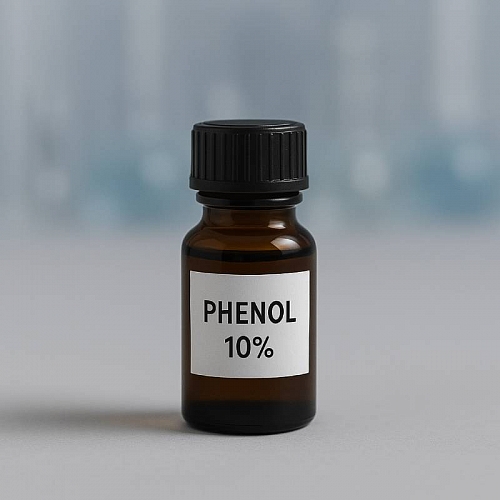



 Out of stock, report an appearance
Out of stock, report an appearance Buy in 1 click
Buy in 1 click

 Add a review
Add a review To favorites
To favorites To compare
To compare Not available
Not available



 Add to cart
Add to cart

